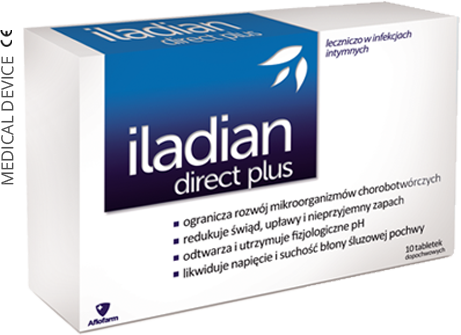
Infections
What is an intimate infection?
Vaginal infections occur when the bacterial flora balance is upset.
If this is the case, the physiological microorganisms (mainly Lactobacillus type bacteria) are in minority and other, potentially pathogenic microorganism, take over the environment. Intimate infections may be broken down by the type of their causes.
The most common are the infections of the types as follows:
- bacterial
- fungal
- mixed
- caused by protozoa
Vaginal infections may be accompanied by vulva infection. Most frequent symptoms of such infections are:
- Discharge which is frequently excessive and of different colour (white, yellow, grey) and consistency (e.g., cheesy),
- burning of vulva and urethra outlet areas,
- itching of vulva and urethra areas,
- redness of external genital organs,
- pain and discomfort during sexual intercourse,
If you notice one of the above symptoms, start your treatment as soon as possible to minimise potential development of further infection.
Types of intimate infections
Three most common types of intimate infections include: bacterial vaginal infection, vaginal
yeast infection or mixed infection caused by both bacteria and fungi.
| bacterial infection | yeast infection | normal | |
| vaginal pH |
> 4,5 | 3,8 – 4,2 | ≤ 4,5 |
| discharge | grey, milky | white, cheesy | transparent, mucus-like |
| odour | unpleasant, fishy | sweetish | odourless |
| symptoms | burning, itching | persistent itching, burning | no symptoms of local infection |
Bacterial infection
Bacterial vaginal infection (bacterial vaginosis, BV) is caused by the bacteria present in vaginal environment.
Vaginal flora is composed of „good” bacteria (lactic acid rods) and „bad” anaerobic bacteria. Physiological balance
means that there are more of the good bacteria. However, if the number of anaerobic bacteria is higher than
the number of lactic acid rods, a bacterial vaginal infection occurs. Such infections are accompanied by white
and grey colour vaginal discharge which is often of watery consistency and a characteristic „fishy” odour.
Yeast infection
Vaginal yeast infection is one of the most common female intimate infection. It is mainly caused by Candida type yeasts.
Symptoms of vaginal yeast infection usually occur during the weakening of immune system. Why? Yeasts occasionally
occur naturally in the vagina, but when the pH balance is upset, they are not neutralised and take over the vaginal
environment, thus causing infection. Yeast infections may also occur when pathogenic organisms enter from
the external environment (e.g., from a sexual partner).
Vaginal yeast infection may be diagnosed based on:
- Different vaginal discharge – white, cheesy discharge of characteristic yeasty smell
- Persistent itching and burning, most commonly not only of the vagina – vaginal yeast infection usually gets to external genital organs which is connected with vulva itching
- Redness of vulvar lips – vaginal yeast infection is commonly accompanied by vulvar lips rush and swelling
Mixed infection
Vaginal microbiological environment is composed of lactic acid rods, anaerobic bacteria and sometimes yeasts. If vaginal acidic pH balance is upset, the number of bacteria harmful for woman’s health increases (so called bad vaginal bacteria). Such imbalance causes vaginal bacterial infections. But that’s not all. Sometimes, some women may suffer from secondary yeast infection. Then, we have to deal with mixed intimate infection – bacterial and yeast.
What contributes to intimate infections?
antibiotic therapy – destroys not only pathogens, but also bacteria necessary for microbiological body balance, including vaginal balance
contraception – regular hormone intake may change acidic pH into more alkaline, thus making the environment perfect for unwanted microorganisms
pregnancy – hormonal changes may result in worse epithelium hydration, thus causing higher risk of microinjuries
menopause – age-related changes in the organism result in hormone fluctuations which may increase the risk of intimate issues
diabetes – increased blood glucose is a perfect medium for Candida albicans; women with high blood glucose are not only prone to yeast infections, but also experience distressing symptoms and the treatment lasts longer and is more difficult
bad intimate hygiene habits – too frequent irrigations which may disturb natural balance of vaginal environment, using liquid soaps or gels which are not dedicated for intimate use, cleaning intimate areas wrong, etc.
frequent visits to swimming pools, sauna, solarium, jacuzzi, etc.
częste korzystanie z basenu, sauny, solarium, jacuzzi itp.






